Written by Paula E. Cushing, Ph.D., Chair, CMCF Fellowship and Grants Committee
The mission of the Colorado Mountain Club Foundation is to raise, manage, and distribute funds to support the stewardship, conservation, education, and other programs of the Colorado Mountain Club and other similar organizations. Since 1982 The Colorado Mountain Club Foundation has awarded fellowships and grants for research consistent with the statement of purpose adopted by the founders of the Colorado Mountain Club in 1912:
To unite the energy, interest and knowledge of the students, explorers, and lovers of the mountains of Colorado; to collect and disseminate information regarding the Rocky Mountains in behalf of science, literature, art and recreation; to stimulate public interest in the mountain area; to encourage the preservation of forests, flowers, fauna and natural scenery; and to render readily accessible the alpine attractions of this region.
The Foundation solicits applications from students enrolled in colleges and universities conducting research in the Rocky Mountain region. The Foundation awards grants ranging from approximately $500 to $2,000, in disciplines such as biology, archaeology, chemistry, environmental studies, forestry, geography, geology, and history. The top three outstanding applicants are awarded a named fellowship: either the Neal B. Kindig Fellowship, in honor of the late Dr. Kindig, a graduate of West Point and Stanford University and professor of electrical engineering at the University of Colorado, as well as an active member of The Colorado Mountain Club and The CMC Foundation; the Kurt Gerstle Fellowship, in honor of the late Dr. Gerstle, professor of engineering at the University of Colorado, a long-time member of CMC, and the founder of the Foundation’s Academic Fellowship program; or the Al Ossinger Fellowship, in honor of Dr. Ossinger, a graduate of Stanford University, a long-time member of CMC and the Foundation, and retired chair of the Academic Fellowship Committee.
In 2021, the CMCF Fellowship and Grants committee was able to support 10 worthy students. Below are highlights from each recipient’s 2021 research.
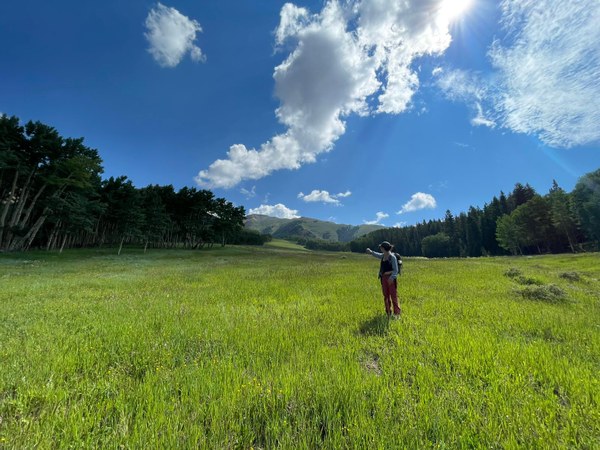
Erin Carroll, PhD student at the University of California, Berkeley, received the $2,000 Gerstle Fellowship for her project, “The mechanism and historical impact of polyploidy on drought response in quaking aspen (Populus tremuloides).” This project examines how quaking aspen trees (Populus tremuloides) respond to drought. With droughts increasing and quaking aspen groves across the Rocky Mountains experiencing high levels of mortality, it is important that we understand why some quaking aspen populations are more severely damaged by drought than others. Understanding the drivers of this apparent variation in drought mortality risk within the species will enable land managers to identify areas that may be important seed sources for climate-resilient restoration efforts, as well as high-risk or low-risk areas to prioritize for future management. Specifically, this project aims to test the hypothesis that cytotype, or number of chromosome copies, is a driver of within-species variation in drought mortality risk. Quaking aspen trees can grow with either two (diploid) or three (triploid) copies of each chromosome. To test this hypothesis, Erin spent the summer at the Rocky Mountain Biological Laboratory in Gothic, Colorado, collecting wood cores from trees with known cytotype from the surrounding watersheds. The CMCF grant supported this fieldwork. Erin will process these tree cores in a laboratory at the University of California, Berkeley. Each tree core records the entire history of an individual tree’s response to its surrounding environment, growing wider annual rings when conditions are favorable and smaller rings when conditions are more stressful, as with drought. Tree cores also contain a section of the tree’s hydraulic architecture, allowing us to measure the size and shape of the vessels that the tree uses to transport water. The tree cores will thus allow Erin to compare both the hydraulic architecture of diploid and triploid aspen and historical records of their drought responses.
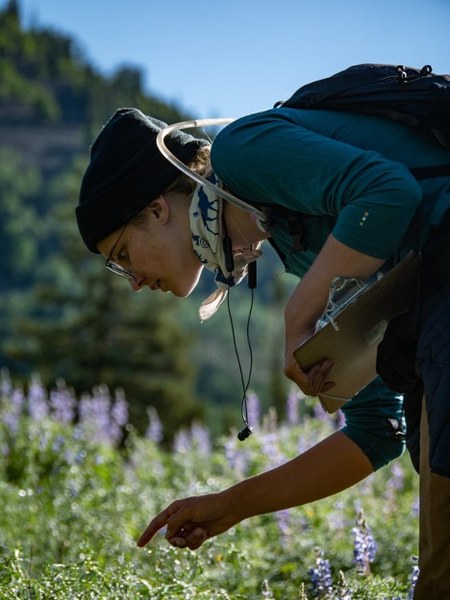
Elsa Godtfredsen, PhD student at Northwestern University and Chicago Botanic Garden, received the $2,000 Kindig Fellowship for her project, “ Early snowmelt, changing phenology and increased drought exposure: consequences for plant survival and reproduction of four subalpine plant species.” In the summer of 2021, Elsa conducted the first field season of her PhD research at the Rocky Mountain Biological Laboratory (RMBL) with support from CMCF. She studied subalpine plants and how climate change is impacting their reproduction and survival through changes in snowmelt. Snowmelt is a vital spring water source and also cues the phenology (life cycle event timing) of subalpine plants. Climate change is causing snowmelt to happen earlier in the spring, which can affect plant-pollinator interactions, plant reproduction, and plant survival; over time, these impacts could threaten plant species persistence in mountain areas. In her research, Elsa experimentally changed snowmelt timing to understand the consequences of climate change for subalpine plants. Specifically, she used shade cloth set out in early spring to cause earlier snowmelt and then measured the flowering phenology, plant and flower size, flower rewards (nectar and pollen), pollinator visitation frequency, drought stress, survival, and number of seeds of four subalpine plant species. The support from the CMCF grant allowed Elsa to purchase a porometer (a device that measures drought stress). Elsa conducted the snowmelt experiment and measured the above traits on a total of 240 individual plants from early May to late August. Preliminary results suggest that while earlier snowmelt prompted earlier flowering and reduced pollinator visitation in all species monitored, other reproductive effects of earlier snowmelt may be species specific. For example, some species had reduced flower size and fruit number in the earlier snowmelt treatment but other species did not. Understanding the reproductive impacts of early snowmelt and which species may be more vulnerable to climate alterations will allow us to better predict climate changes impacts on mountain ecosystems.
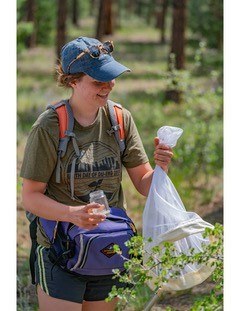
Blyssalyn Bieber, Master of Science student at the University of Denver, received the $2,000 Ossinger Fellowship for her project, “Effects of fire severity on the floral visitor community, pollination, and reproduction of a dominant flowering sub-alpine shrub.” Anthropogenic climate change is driving extreme fire events with lasting effects on biological communities and the ecosystem services they provide. The Rocky Mountains have forests that are recovering from mixed severity wildfires that burned ~20 years ago, which can help us understand how native bees and their pollination services are impacted by long-term by fire severity. To determine how fire severity impacted bee visitation and pollination of a dominant flowering shrub, Blyssalyn and her colleagues sampled the community of native bees foraging on wax currants (Ribes cereum) throughout the flowering season in high severity, low severity, and unburned sites in the Pike National Forest. By comparing abundance and diversity of native bees visiting R. cereum, they saw a trend of both lowest diversity and lowest abundance at low severity sites. Notably, they were the first to document the pollinator community for R. cereum and found that native bees in the genus Lasioglossum were the most common pollinator at all fire severities. They simultaneously conducted a pollinator exclusion experiment using R. cereum to compare effects of pollination services across fire severities. Full pollinator exclusion had the lowest mean fruit set indicating native bees are effective pollinators. Additionally, they found that fire severity did not affect fruit set. This study bridges a knowledge gap in our understanding of how climate change will influence ecosystem services within the Rocky Mountain region.
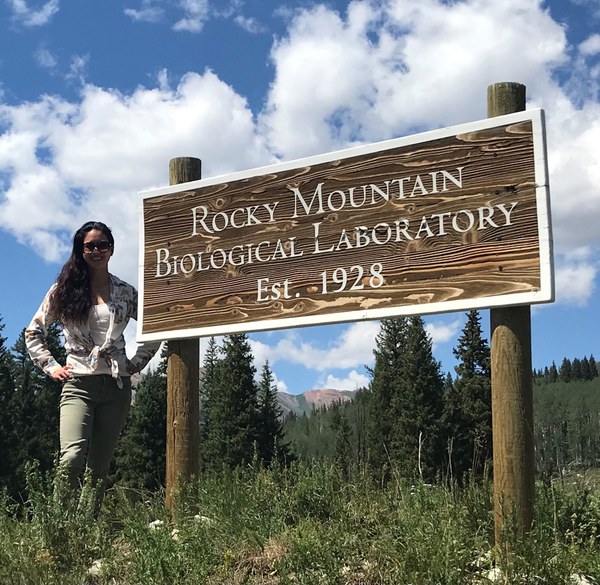
Kaysee Arrowsmith, PhD student at the University of Washington, received a $1,000 grant for her project, “Effects of climate on plant-pollinator interaction patterns.” Her research explores the effects of environmental variables (temperature and soil moisture) on plant-pollinator interactions. In other words – if pollinators have the opportunity to visit the same plant species in many different ecological contexts, what environmental conditions make them more or less likely to take advantage of that opportunity? In 2021, she was able to explore this question on two different time scales. Over the course of the entire summer, she compared plant-pollinator interactions at 15 sites and connected these interaction patterns to temperature and soil moisture measurements. CMCF funds were crucial for purchasing the supplies to collect these measurements, including HOBO Pendant data loggers that were installed at each site for the entire summer to collect temperature measurements every 30 minutes. These fine-scale, site-specific temperature measurements represent crucial data that allow measurement of the precise temperature at which a particular plant-pollinator interaction takes place. Kaysee also explored changes in plant-pollinator interactions at the time scale of individual days. In total, Kaysee and her team recorded 2,654 plant-pollinator interactions across 15 sites between May 6 and August 5, 2021. Of these data, 1,179 interactions also supported her analysis of plant-pollinator interaction variation within single days, spread across 24 separate days. Preliminary analysis of the data suggests that both temperature and soil moisture significantly influenced variation in plant-pollinator interactions across the sites, with greater difference in both variables associated with a larger variation in interactions between any pair of sites.
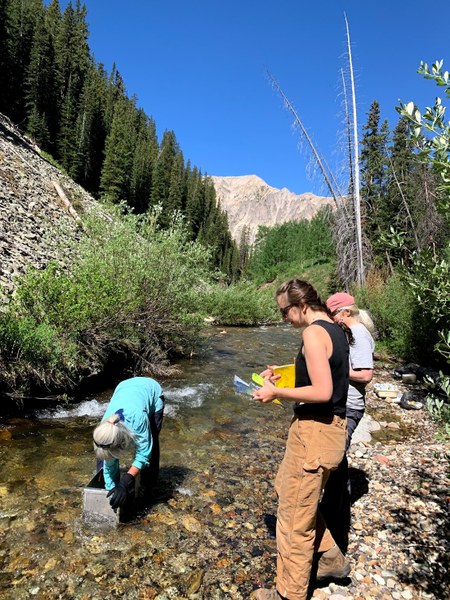
Mairead Brogan, undergraduate student at the University of Colorado, Boulder, received a $1,000 grant for her project, “The impact of Didymosphenia geminata on the community structure of invertebrates in western Colorado streams.” During the past summer, Mairead was able to investigate the impact of the nuisance diatom, Didymosphenia geminata, on stream invertebrate community structure. This study builds on a 46-year record of macroinvertebrate community composition in eight streams around the Rocky Mountain Biological Lab, including surveys of D. geminata proliferation since 2013. The long-term relationships between animal and plant species and their relationships to their abiotic environment are closely tied to climate change. Stream macroinvertebrates represent excellent indicators of the quality of freshwater habitats and respond measurably to environmental changes. Previous studies have demonstrated that under low-flow (drought) and low-nutrient (phosphorus) conditions, the diatom D. geminata exhibits nuisance growth patterns by putting out non-photosynthetic polysaccharide stalks, blanketing the bottoms of streams in thick algal mats. As climate change accelerates and weather extremes intensify, streams in the Colorado Rockies are experiencing more low-flow summers, thereby exacerbating D. geminata blooms. Such proliferation of nuisance growth of D. geminata has the potential to affect the mobility and food acquisition of freshwater invertebrate indicator species associated with otherwise pristine conditions in these high elevation streams. Results of this study showed that increases in D. geminata proliferation caused significant shifts in invertebrate community structures specifically decreasing Heptageniidae (mayfly) abundance and increasing Chironomidae (midge) abundance. This indicates degradation of stream habitat for invertebrates and reduction of the food resources for trout fisheries.
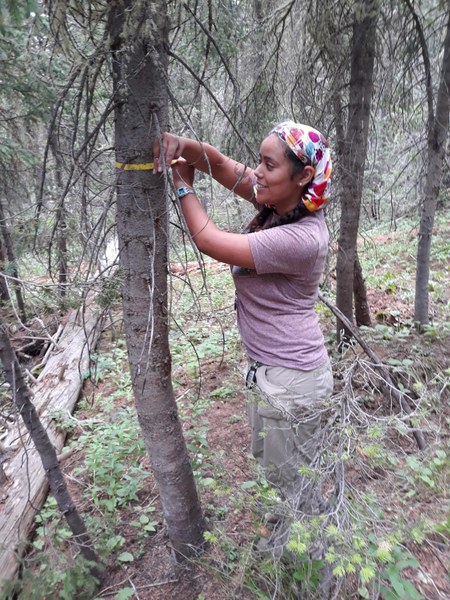
Olivia Santiago, Master of Science student at Colorado State University, received a $500 grant for her project, “Is climate warming the culprit for western spruce budworm outbreaks in the northern Colorado Rocky Mountains?” The underlying question of Olivia’s research is whether climate impacts the onset of western spruce budworm (WSB) outbreak in the Colorado Rockies and uses tree ring analysis to answer that question. Olivia hypothesized that precipitation or lack thereof impacts the initiation of outbreak by altering the availability and quality of food for the budworms. To test this hypothesis, Olivia needed the centuries’ long records of tree rings from host and non-host trees to correlate outbreaks with climate. Therefore, she collected two cores from about 160 Douglas fir trees, a host of WSB, and two cores from about 80 ponderosa pine trees, a non-host that captures climate signals. Olivia is now analyzing the data and plans to complete her master’s degree in May 2022.
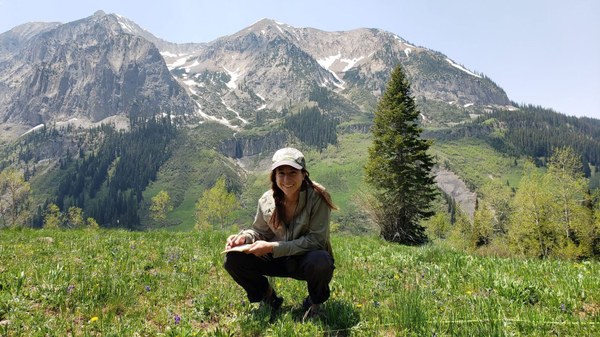
Erika Sarro, PhD student at University of California, Riverside, received a $1,000 grant to support her project, “Bumble bee queen foraging behavior and nesting success in response to resource availability.” Bumble bee queens initiate new nests independently each spring, at which time they carry out all tasks related to larval rearing and nest maintenance. This foundational stage of the bumble bee life cycle is thought to be particularly sensitive to environmental stressors, which may help explain national and global declines in bumble bee populations. However, the colony founding stage and the factors that limit its success remain severely understudied. In the summer of 2021, Erika produced the first-ever continuous records of bumble bee queen foraging behavior into and out of the nest. These data are a first step in identifying how solitary queens juggle the various demands on their time and energy in the early stages of the colony. This past summer, Olivia placed wooden nesting boxes at the Rocky Mountain Biological Laboratory (RMBL) in early spring and trap-nested three wild bumble bee queens (Bombus appositus, B. rufocinctus, and B. centralis). After queens laid eggs in the nest boxes, she tagged them with radio frequency identification (RFID) tags and placed RFID readers at each nest entrance. RFID readers continuously recorded the queens’ comings and goings from the nest for nearly their entire flight periods (roughly 3 weeks). Preliminary results suggest that queens made 10-15 foraging trips per day, each lasting an average of 20 minutes. Queens ceased foraging one week after workers were observed in the nest. These trends were consistent across all recorded individuals. All nests successfully grew and produced both workers and new queens. Subsequent research will use these newly established methods to identify whether queens can compensate for diminished floral resources by altering their foraging behavior. An improved understanding of plasticity during this life stage may help predict bumble bee responses to a changing world.
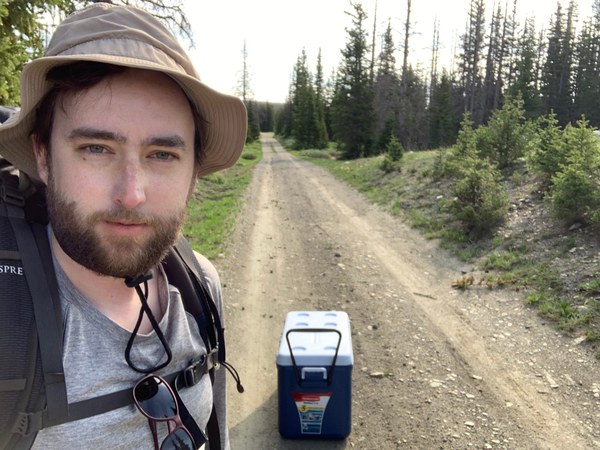
Avery Tucker, PhD student at the University of Memphis, received a $1,000 grant for his project, “Beyond the pale: expanding research methods for snow microbiology studies.” The goals of this project are to explore the temporal microbial dynamics of alpine snows using treatment plots that take into account the unique properties of snow as factors influencing community structure. The research will examine snow microbiology using the Rocky Mountains as a staging ground and will shed light on pollen’s contribution to the snow community food web, enhance prediction of snow algae bloom occurrence, and promote snows in the Rocky Mountains as a unique reservoir of life. While the initial project was intended for Niwot Ridge, the Glacier Lakes Experimental Ecosystem Site (GLEES) was chosen instead as the appearance of the snow algae Sanguina nivaloides was thought to be more reliable there during a year with unusual snow melt conditions. The study design was also shifted to focus on the successional dynamics at the snow/soil interface due to field conditions that made the use of microcosms infeasible. Avery collected nearly 300 snow and soil samples from the Rocky Mountains that were preserved at less than 0°C and driven back to the University of Memphis. Currently, samples are being processed for genomic DNA and as of today, approximately 130 samples have been processed.
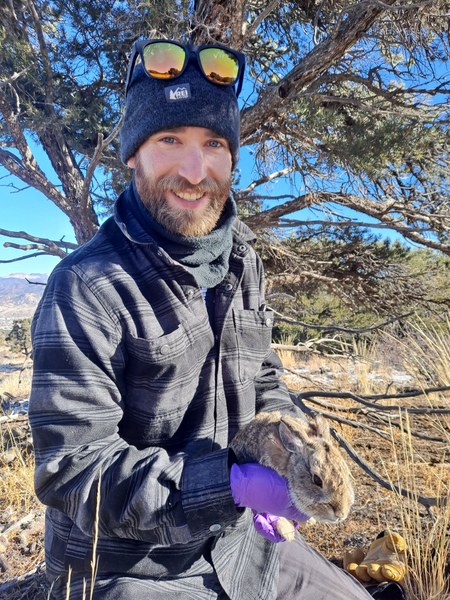
Eli Wildey, Master of Science student at Colorado State University, Pueblo campus, received $1,000 for his project, “Does human disturbance redefine winners and losers in the wildlife community along a trail network in Salida, Colorado.” Eli’s project focuses on the changes in behavior and movement of wildlife species in response to human recreation on the Methodist Mountain trail system outside of Salida. The goal of this research is to see how changes in the behavior and movement of multiple species—mule deer, mountain cottontail rabbits, coyotes, bobcats, and foxes—impacts the way these species interact with each other as part of a wildlife community and how we might mitigate our impacts so we can recreate responsibly. Eli set up his tracking array that will receive radio signals emitted by collars attached to study species, allowing him to track wildlife movements every 5 minutes; a frequency of locations that until recently was not possible. Leveraging this data, he can tell at a fine scale when and where animals are active. Eli captured and placed tracking collars on 5 mule deer, 7 mountain cottontail rabbits, and will start efforts capturing carnivores shortly. Eli plans to finish his fieldwork by the end of summer 2022 and analyze the tracking data as well as data from trail cameras that will allow him to monitor changes to other wildlife species such as black bear and mountain lion.
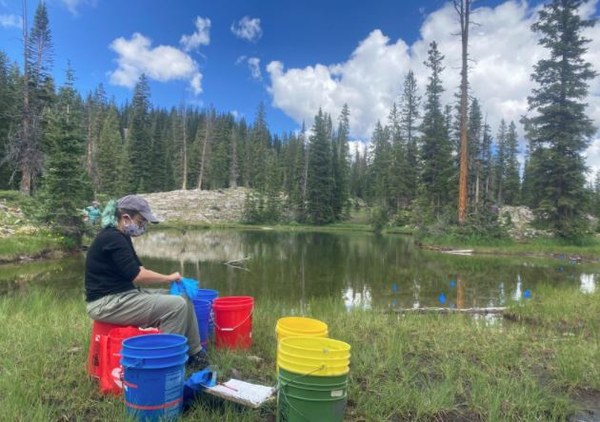
Megan Zerger, undergraduate student at Murray State University, received a $500 grant for her project, “Influence of cannibalism on Arizona tiger salamander (Ambystoma mavortium nebulosum) stress physiology.” Given widespread declines and the effects chronic stress can have on amphibian health, it is important to understand within-population drivers of stress and how population level variation may influence population viability. Morph (terrestrial vs aquatic), sex, and body condition are traits that may influence stress within salamander populations because of differences in physiology and environmental conditions. Thus, the objective of this study was to assess how the stress hormone corticosterone varies within the Arizona tiger salamander (Ambystoma mavortium nebulosum) population at the Mexican Cut Nature Preserve, in the Rocky Mountains of Colorado. Megan and her team used a non-invasive skin swabbing method to collect hormone samples from over 50 Arizona tiger salamanders in July of 2021. Preliminary data shows that metamorph, or terrestrial, individuals had a higher concentration of corticosterone in comparison to aquatic paedomorphs. Additional samples will be processed soon, and will allow Megan to consider variability in corticosterone by sex, body condition, and morph. This study will provide a better understanding of how stress hormones can be used to assess population health and disease susceptibility. Future research utilizing this method could clarify the effects of climatic variation and population density in amphibian populations.
Submissions are open for the 2022 Colorado Mountain Club Foundation Fellowships.
Grants are made to individuals only, for research under the direction of a faculty member of an institution of higher learning. Application must be sent by April 15, 2022 to Paula Cushing at Paula.Cushing@dmns.org. The faculty sponsor must submit a letter under separate cover in support of the student and the proposed research. Previous one-time winners of CMCF fellowships or grants are welcome to apply; however, those who have received CMCF support two previous years or more are ineligible.
2022 CMCF Fellowship Application
Click the button below to stay up to date on all CMCF Fellowship News
 Paula Cushing
Paula Cushing
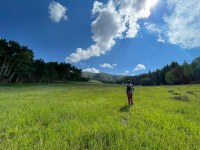
Add a comment
Log in to add comments.